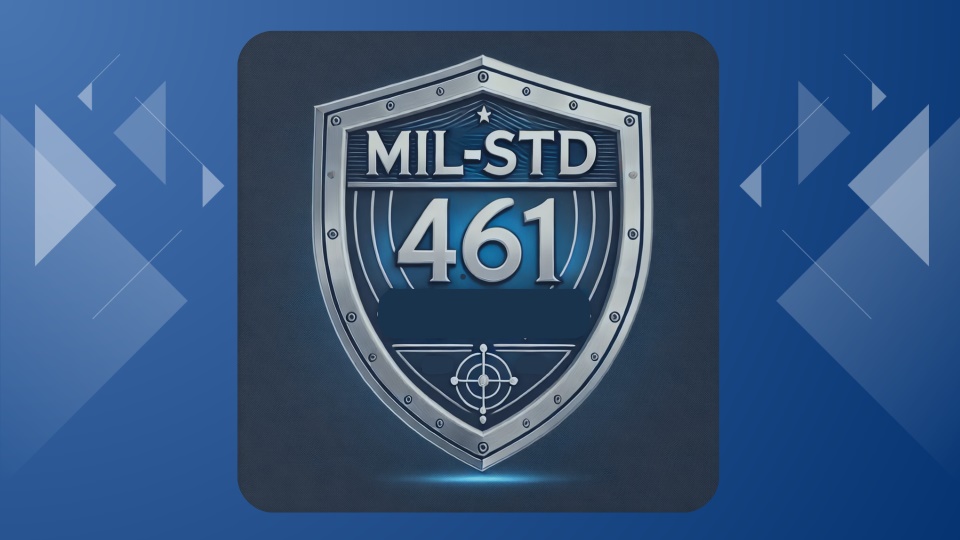MIL-STD 461 TESTS AND THEIR IMPORTANCE

MIL-STD-461 is a standard developed to ensure electromagnetic compatibility (EMC) of equipment used in military and defense systems. This standard is applied to limit the electromagnetic interference (EMI) emitted by devices and to test their resilience against external electromagnetic influences. Published by the U.S. Department of Defense, this standard is of great importance to ensure the reliable and smooth operation of military devices. Electromagnetic compatibility is a critical factor in military operations, as it requires devices to work in harmony with each other and their surrounding environment.
These tests are generally divided into two main categories: emission and susceptibility tests. Emission tests measure the electromagnetic emissions from devices to ensure that they stay within levels that won't negatively affect other systems. For instance, the CE101 and CE102 tests evaluate low and high-frequency emissions in power lines, while the RE101 and RE102 tests assess the magnetic and electric field emissions from the device. Susceptibility tests examine how devices respond to external electromagnetic influences. Tests like CS101, CS114, and CS116 measure the resilience of devices to interference from power and signal lines, while RS101 and RS103 evaluate resistance to magnetic and radio frequency fields.
One of the primary reasons for applying these tests is to guarantee that military devices work smoothly in environments with high electromagnetic pollution. Especially critical devices like radar systems, communication equipment, and weapon systems must continue to function without being affected by electromagnetic interference. Furthermore, ensuring compliance with international military standards is another important necessity for these tests.
MIL-STD-461 tests are performed in special environments that are free from electromagnetic effects. A Faraday cage provides a completely isolated area from external electromagnetic interference, enhancing the reliability of the tests. Anechoic chambers absorb electromagnetic waves, creating the most realistic testing conditions. Additionally, laboratory tests evaluate the conductive emissions and susceptibility levels of devices. In some cases, field simulation tests are conducted to understand how devices respond in operational environments.
From a technical standpoint, MIL-STD-461 tests require highly sensitive measurement devices and specialized equipment. The test process begins by placing the device in the appropriate test environment and making the necessary connections. Once the measurement devices are calibrated, tests are conducted according to established protocols, and the resulting data is analyzed in detail. Spectrum analyzers are commonly used to measure electromagnetic emissions, while EMC antennas are used to detect electromagnetic fields during the test. RF amplifiers provide strong signals to devices during susceptibility tests with radio frequencies. Current and voltage probes measure conductive emissions from power and signal lines, and pulse generators simulate rapid transient events and electromagnetic bursts.
For example, during CE101 and CE102 tests, low-impedance circuits are used to measure emissions from power lines, ensuring that the electromagnetic energy emitted by the device's power source does not exceed threshold limits. During the RS103 test, the device is exposed to a high-powered electromagnetic field within a specific frequency band, and its sensitivity to radio frequencies is measured. In CS115 and CS116 tests, the device's response to fast transient pulses and electromagnetic bursts applied to power and signal lines is assessed.
In conclusion, MIL-STD-461 tests play a critical role in ensuring that military devices are electromagnetically reliable, durable, and compatible. As electromagnetic interference can cause serious issues in modern military operations, this standard ensures that devices work seamlessly with each other. For manufacturers, compliance with this standard is crucial for gaining a competitive advantage in the international market. Ensuring electromagnetic compatibility not only enhances military security but also allows technology manufacturers to develop innovative and reliable products for the future.
At Ruggmate, we ensure that our keyboards are fully compliant with MIL-STD-461 standards by considering electromagnetic compatibility criteria from the design phase onward. To guarantee the reliability and durability of our products, we conduct comprehensive EMC testing at accredited test centers. This ensures that our keyboards, used in critical defense systems, operate flawlessly even in the most challenging electromagnetic environments, maximizing customer satisfaction and operational safety.